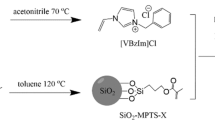Abstract
Silica nanoparticles synthesized by using TEOS/CTABr/NH4OH/H2O were modified with a grafting method using organic amino functional groups. The physical properties of the surface-modified nanoparticles and their sorption behavior with regard to radioactive cobalt and the effect of the surfactant on the sorption were evaluated. The surface-modified nanoparticles had a non-hexagonal structure owing to the partial collapse of the mesopore wall on the surface of the silica nanoparticle. The cobalt sorption capacity increased with the number of amine groups within the organic functional group. An evaluation of the effect of surfactant on cobalt sorption found that the sorption performance was reduced by 0.1 mg/g.







Similar content being viewed by others
References
Cheever CL, Rose RW (1996) Decontamination of hot cells K-1, K-3, M-1, M-3, and A-1, M-Wing, Building 200: Project final report
Fournel B, Angot S, Joyer P (2002) Decontamination of phebus experimental target chamber using sprayed foam. In: International conference on nuclear engineering, proceedings, ICONE, vol 1, pp 835–844
Nabemoto T, Katahira F, Sakaya T, Aose S, Kitajima T, Ogasawara K, Nomura K, Miyachi S, Ichige Y, Shinozaki T, Ohuchi S (2008) Experience of hot cell renovation work in CPF (Chemical Processing Facility). American Nuclear Society, La Grange Park
Richert SH (1979) Physical-chemical properties of whey protein foams. J Agric Food Chem 27:665–668
Turchet JP, Fournel B, Estienne G (2002) Pipe decontamination involving “string-foam circulation”. In: International conference on nuclear engineering, proceedings, ICONE, vol 1, pp 823–834
Fletcher PDI, Holt BL (2011) Controlled silanization of silica nanoparticles to stabilize foams, climbing films, and liquid marbles. Langmuir 27(21):12869–12876
Horozov TS, Aveyard R, Clint JH, Binks BP (2003) Order-disorder transition in monolayers of modified monodisperse silica particles at the octane-water interface. Langmuir 19:2822–2829
Yoon SB, Yoon IH, Kim C, Jung CH, Kim S, Choi WK, Moon JK (2014) Morphological control of mesoporous silica nanoparticles and their application for foam stability. Asian J Chem 26:1401–1404
Jung CH, Yoon IH, Kim CR, Yang HB, Choi WK, Moon JK (2015) Stability of foaming agent for foam decontamination. Asian J Chem 27:4254–4256
Yoon IH, Yoon SB, Jung CH, Kim C, Park SY, Moon JK, Choi WK (2014) Decontamination foam containing silica nanoparticles of various structures. Asian J Chem 26:1405–1407
Evangelista SM, DeOliveira E, Castro GR, Zara LF, Prado AGS (2007) Hexagonal mesoporous silica modified with 2-mercaptothiazoline for removing mercury from water solution. Surf Sci 601:2194–2202
Dey RK, Oliveira FJVE, Airoldi C (2008) Mesoporous silica functionalized with diethylenetriamine moieties for metal removal and thermodynamics of cation-basic center interactions. Colloids Surf A 324:41–46
Kim YH, Lee B, Choo KH, Choi SJ (2011) Selective adsorption of bisphenol A by organic-inorganic hybrid mesoporous silicas. Microporous Mesoporous Mater 138:184–190
Park Y, Kim C, Choi S-J (2014) Selective removal of Cs using copper ferrocyanide incorporated on organically functionalized silica supports. J Radioanal Nucl Chem 303:199–208
Zhao XS, Lu GQ, Millar GJ (1996) Advances in mesoporous molecular sieve MCM-41. Ind Eng Chem Res 35:2075–2090
Vallet-Regi M, Rámila A, del Real RP, Pérez-Pariente J (2001) A new property of MCM-41: drug delivery system. Chem Mater 13:308–311
Huh S, Wiench JW, Yoo JC, Pruski M, Lin VSY (2003) Organic functionalization and morphology control of mesoporous silicas via a co-condensation synthesis method. Chem Mater 15:4247–4256
Benhamou A, Baudu M, Derriche Z, Basly JP (2009) Aqueous heavy metals removal on amine-functionalized Si-MCM-41 and Si-MCM-48. J Hazard Mater 171:1001–1008
Mureseanu M, Reiss A, Stefanescu I, David E, Parvulescu V, Renard G, Hulea V (2008) Modified SBA-15 mesoporous silica for heavy metal ions remediation. Chemosphere 73:1499–1504
Zhao Y, Gao Q, Tang T, Xu Y, Wu D (2011) Effective NH2-grafting on mesoporous SBA-15 surface for adsorption of heavy metal ions. Mater Lett 65:1045–1047
Park SJ, Jun BR, Kawasaki J (2004) Influence of surface properties of MCM-41 on Cr(III) and Cr(VI) adsorption behaviors. J Korean Ind Eng Chem 15(1):11–16
Lowell S, Shields E (1991) Powder surface area and porosity, 3rd edn. Chapman&Hall Ltd, London
Yoshitake H (2005) Highly-controlled synthesis of organic layers on mesoporous silica: their structure and application to toxic ion adsorptions. New J Chem 29(9):1–11
DeOliveira E, Prado A (2007) Ethylenediamine attached to silica as an efficient, reusable nanocatalyst for the addition of nitromethane to cyclopentenone. J Mol Catal A 271:63–69
Cotton FA, Wikinson G, Murillo CA, Boch Mann M (1999) Advanced inorganic chemistry, 6th edn. Wiley, New York
Yokoi T, Yoshitake H, Yamada T, kubota Y, Tatsumi T (2006) Amino-functionalized mesoporous silica synthesized by an anionic surfactant templating route. J Mater Chem 16:1125–1135
Acknowledgments
This work has been carried out under the Nuclear R&D Program (2012M2A8A5025655) funded by Ministry of Science, ICT & Future Planning.
Author information
Authors and Affiliations
Corresponding author
Additional information
Chorong Kim and Chong-Hun Jung have contributed equally to this work.
Rights and permissions
About this article
Cite this article
Kim, C., Yoon, IH., Jung, CH. et al. Sorption of cobalt by amine-functionalized silica nanoparticles for foam decontamination of nuclear facilities. J Radioanal Nucl Chem 310, 841–847 (2016). https://doi.org/10.1007/s10967-016-4886-2
Received:
Published:
Issue Date:
DOI: https://doi.org/10.1007/s10967-016-4886-2




